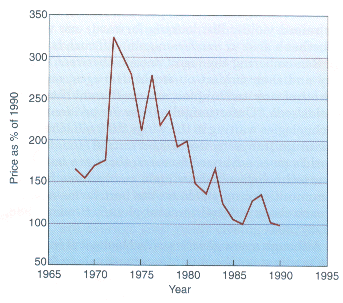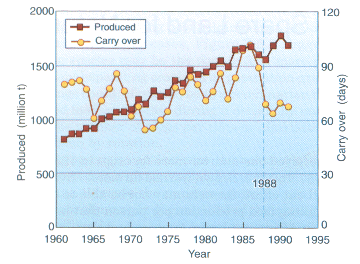 Figure 8.1.1. Skyrocketing U.S. soybean prices and their fall. The
price is expressed relative to 1990 in constant
dollars calculated by the consumer price index (U.S.
Department of Agriculture, various years). [USDa]
Figure 8.1.1. Skyrocketing U.S. soybean prices and their fall. The
price is expressed relative to 1990 in constant
dollars calculated by the consumer price index (U.S.
Department of Agriculture, various years). [USDa]
From time to time, bad weather or disorder disturbs the production of food, prices rise, and people grow pessimistic about production. When supply recovers, inflated prices fall, and farmers grow pessimistic about their income. Foreseeing the future and the land that humanity can spare demands peering through these fluctuations.
Two examples illustrate. Near 1970 in the United States, Southern corn leaf blight, an early frost, and a Russian wheat deal combined to disturb American farming, raising beef prices, inciting a meat boycott, and restricting soybean exports. In 1977, Congress required appraisal of the condition and of the trends of the soil and water resources of private land.
Pessimism about the food supply helped lift prices of midwestern farm land and production of Brazilian soybean. The appraisal required by Congress projected that almost 160 million ha of cropland would be required in 2030 (U.S. Department of Agriculture, 1981[USD81]; 1990[USD90a], 12).
When the dust settled, the price of midwestern farms plummeted, bankrupting farmers and banks. A new appraisal projected that the United States would need only 90 million ha of cropland in 2030. The academic legacy was that of eating crow as estimates were chopped. The practical legacies were Brazilian competition and falling prices for American soybeans (U.S. Department of Agriculture various years[USDa]) (Figure 8.1.1.).
 Figure 8.1.1. Skyrocketing U.S. soybean prices and their fall. The
price is expressed relative to 1990 in constant
dollars calculated by the consumer price index (U.S.
Department of Agriculture, various years). [USDa]
Figure 8.1.1. Skyrocketing U.S. soybean prices and their fall. The
price is expressed relative to 1990 in constant
dollars calculated by the consumer price index (U.S.
Department of Agriculture, various years). [USDa]
The U.S. drought of 1988 provides the second example of fluctuation and pessimism. From 1987 to 1988, U.S. production of grain fell one-quarter, and U.S. stocks nearly halved. During 1988, the world produced 7% less grain than during the peak year of 1986; at the end of 1988, global grain stocks were one-third less than their peak at the end of 1986.
The drought combined with forecasts of a worsening climate, an end to the expansion of irrigation, and a lack of technology on the shelf to encourage baleful forecasts of food security. Subsequently, U.S. farmers received one-quarter more for crops in 1989 than in 1987. In 1988, Brown warned farmers: ``Even with an all-out effort, farmers may not be able to reverse the falling food production per person that is underway in Africa and Latin America and that is threatening the Indian subcontinent, unless they can get help from family planners. ...Ensuring adequate food supplies during the nineties and beyond will require far more of the attention of political leaders. ... Unless national governments are prepared to wage the war against hunger on a far broader front, it may not be possible to arrest the decline in per capita food production that is now undermining the future of so many poor countries" (Brown, 1988,[Bro88] 51).
Providing the wisdom of hindsight, Figure 8.1.2 shows that the alarming decline in world grain production from 1986 to 1988 was a fluctuation rather than a trend. Crop prices also fluctuated, as Figure 8.1.1 exemplifies.
 Figure 8.1.2. World production of grain and oilseeds and their
carryover (U.S. Department of Agriculture, 1993). [USD93]
Figure 8.1.2. World production of grain and oilseeds and their
carryover (U.S. Department of Agriculture, 1993). [USD93]
Foreseeing the future accurately demands peering through these fluctuations.